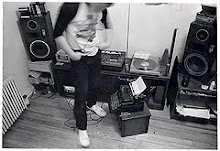
When that big goon approached me on the subway platform I got a bit nervous. And then he started asking me about what was in my instrument case. I was carrying my prized synthesizer, the Korg Poly Six.
I had a theater gig at La Mama Etc. for the 1984 production of
The Memory Theater of Giulio Camillo by the Creation Theater Company. Vito Ricci composed the music, and I played some synthesizer parts in the show. I was on my way home after words when the guy approached me, so it was near midnight.
While it made me a little nervous that the goon started questioning me, I really wasn't too worried. He couldn't exactly run away with the Korg, being that it weighed about 60lbs! But
I couldn't run away from him either, so I found myself in a bit of a standoff. After a little back and forth, I discovered he wasn't looking to rip me off, but rather wanted to recruit me into his ministry which needed a keyboardist for its live service.
I told him I was "exploring Taoism." I think that he thought that it may have meant that I was gay, and he scooted away.
O.k., I just looked it up, the Poly-Six is 11.2kg which comes to like 25lbs. It seemed much heavier at the time. Maybe that's because my memories of it are so solidly positive. It had a good build — metal, with wood side panels. This synth was old school.
The Poly-Six was the first really affordable polyphonic synth, coming in at under $1000 back in 1980-81. But it didn't have MIDI, which was brand new. The price dropped to about $500 or $600 when the next model came out, the Korg Poly 61, which did have MIDI. What the Poly 61 did not have, however, was knobs. That was about the point in history when knobs went away in favor of the tiny liquid crystal display, as in the ubiquitous Yamaha DX7, and everything after it, for quite some time.
The Poly Six sounded great to me. It had a more simple voice architecture than the
Pro-One I'd had before, but it was POLYPHONIC. You could also stack all six voices into a hugely thick monophonic voice. It had a chorus on it and memory, so yes, finally I could save my patches. You could invert the envelopes with the twist of a knob.
Très cool.
I recorded a bunch of tunes with this, but traded it in at Rogue Music in Manhattan. I still remember how happy to take it off my hands they were, so I knew I wasn't getting top dollar on it. But it was too heavy to take home. As time passed and I listened to my recordings of it, I realized how much I missed the analog sound of the thing. Everything went cold and digital after that. FM synthesis is o.k., but it was a lot harder to make your own voices. But I craved MIDI, and was looking toward computers and the future.
I sold the Poly-Six and got myself the
Yamaha CX5m Music computer, which promised to combine computer sequencer based composition with an on-board FM synthesizer complete with computer voicing software and a librarian.
Read all about it.
 This sampler wins the prize as the most ornery piece of gear I've ever owned.
This sampler wins the prize as the most ornery piece of gear I've ever owned.









